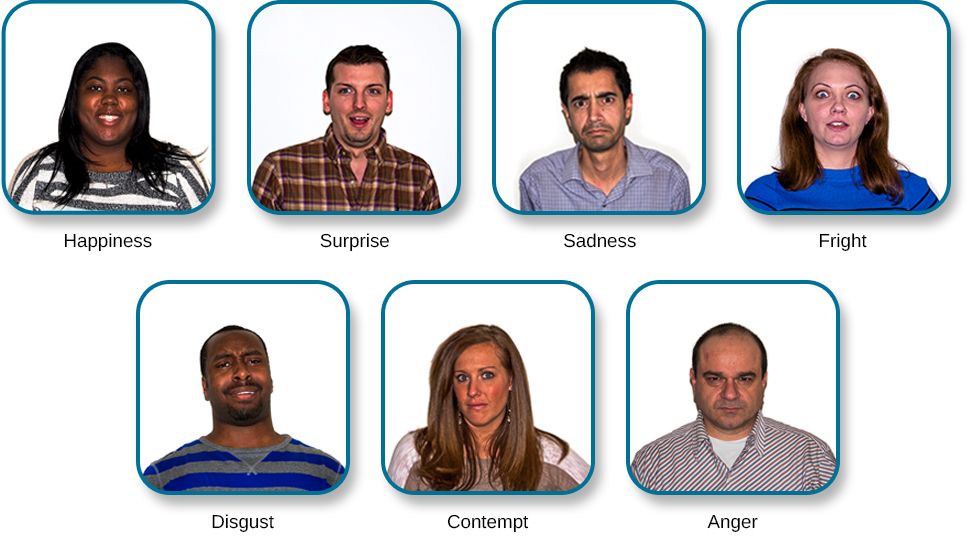3.4 Expression of Emotions
No matter if we want this or not, we are likely to communicate our emotions, including non-verbally and verbally. Emotions are conveyed in various ways, including through facial expression, body language, physiological changes in our body, tone of voice and word choice (Williams & Hinshaw 2018; Freberg, 2019; Holland & Taylor 2015). One topic of debate in the emotions literature focuses on the question of whether people tend to express their emotions in predictable ways, including across cultures, or whether variation is the norm.
The emotions listed below are frequently cited as the major “basic emotions, which are thought to be universal across cultures” (Ekman, 1980; 1992a; 1992b). The research by Ekman and colleagues found that the facial expressions associated with these basic emotions are perceived by people (across sex and culture) as having similar meanings:
| Happy |
| Surprise |
| Disgust |
| Anger |
| Fear |
| Sadness |
| Contempt (sometimes included in Ekman’s work, sometimes not) |
Other scholars have also included the emotions of shame and embarrassment as being universally expressed and recognised.
As previously noted, neuroscience research and more contemporary theories of emotions have challenged the idea that emotions are universal and that they are expressed and can be recognised across cultures (Feldman Barrett, 2017b; Gendron et al., 2015). Contemporary approaches to explaining emotions frequently note that emotional expression and recognition may differ based on the context and culture in which an individual grows up. Focusing on facial expressions (which may be more accurately referred to as ‘facial configurations’), research by Feldman Barrett (2020) found considerable variation in people’s facial movements associated with their emotional states and that these movements frequently depended on the context. Factors that may affect variation in expression include, for example, biological and psychological conditions, personal preferences, situational factors, etc.
Reflection Activity
Please take a moment to think about how you believe you express the above listed emotions. You may find that you express some emotions differently, depending on the context and that there is also great variation in how you express an emotion as compared to your partner/ family members/ friends. You may even struggle to find words for how you believe you express the emotion. This exercise is meant to get you thinking about the variation in the expression of emotion, we are not seeking to develop a stereotypical expression of these emotions.
| Facial Expression (e.g. smile) | Body Language (e.g. clenched fist) | Tone (e.g. voice gets high-pitched) | Words (e.g. insults) | Behaviours associated with the emotion ( e.g. crying) | Other visible physiological changes in your body (e.g. flushing face) | Any felt but invisible changes in your body (e.g. knot in stomach) | |
| Happy | |||||||
| Surprise | |||||||
| Disgust | |||||||
| Anger | |||||||
| Fear | |||||||
| Sadness | |||||||
| Contempt | |||||||
| Embarrassment | |||||||
| Shame |
You may wish to compare the descriptions of your own facial expressions (or others around you) with some stereotypical facial expressions displayed in these photos by actors. Do you believe your facial expression of these emotions matches these stereotypical expressions?

If you haven’t already watched the following video as part of topic 3.2, you may wish to watch the first 2 minutes of this video now for a critical look at the belief in the universality of facial expressions:
For a summary of what you have just learned and for a more detailed discussion on the topic of the expression of emotions, including a critical review of the long-held beliefs in the universality of certain emotions, please watch Sam Hardy discuss the question of why and how we express emotions now (video created by Sam Hardy and used with her permission)[11:07]:
You may think about the question of how “accurately” we can possibly interpret others’ emotions by focusing on their facial expressions in a more critical way after completing this topic and chapter overall. After all, if variation is the norm, perhaps we cannot really learn to ever accurately “read/detect” emotions in other people’s faces. You are likely to read about the topic of facial expressions in numerous readings that consider neuroscience and psychology research for conflict resolution (as well as in popular press), so it is always useful to have some background knowledge on these topics to read relevant publications with a critical eye.
As previously noted, emotions can be conveyed in other ways than facial expressions (Holland & Taylor, 2016), including verbal cues (e.g., tone of voice and word choice), overt behaviours (like crying), as well as visible or invisible physiological changes (e.g., sweating or flushing of the face, dry mouth).
Variations in the Experience and Expression of Emotions
Several factors may influence an individual’s experience and/or “expression” of emotions, as well as a person’s ability to accurately interpret others’ emotions (Freberg, 2019). These factors include, but are not limited to:
- culture
- childhood experiences
- gender
- genetics
- health conditions like Schizophrenia, Autism spectrum disorder, and antisocial personality disorder (for example, bilateral amygdala damage reduces fear, anxiety, and aggression. People with ASD may have abnormal amygdala which compromises their ability to read fearful faces (and to make eye contact)
- individual choices and training (e.g., health professionals undergo training to suppress expressing disgust)
- personality
- situational factors like the presence of others, the individual’s mood in the situation
- goals of the individual.
Reflection Activity
Can you think of any other factors that may influence an individual’s expressions and experience of emotions, and their ability to notice emotional cues in others?

